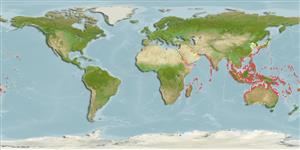Common names from other countries
Environment: milieu / climate zone / depth range / distribution range
Écologie
marin récifal; profondeur 0 - 60 m (Ref. 128797). Tropical; 42°N - 35°S, 20°E - 158°W
Indo-Pacific: East Africa to Micronesia and Samoa, north to southern Japan, south to New South Wales. Replaced by Arothron diadematus in the Red Sea (Ref. 37816, Ref. 84159).
Taille / Poids / Âge
Maturity: Lm ? range ? - ? cm
Max length : 33.0 cm TL mâle / non sexé; (Ref. 9710)
Épines dorsales (Total): 0; Rayons mous dorsaux (Total): 10-11; Épines anales 0; Rayons mous anaux: 10 - 12. Body covered with prickles (Ref. 559) and with large black spots (Ref. 4919).
Inhabit coastal to outer reef crest and slopes with rich invertebrate growth. Sometimes solitary (Ref. 90102). Adults often in pairs (Ref. 48637). Feed on corals (usually Acropora tips), crustaceans, mollusks, sponges, tunicates and algae (Ref. 2334). Generally common (Ref. 9710).
Life cycle and mating behavior
Maturité | Reproduction | Frai | Œufs | Fécondité | Larves
Randall, J.E., G.R. Allen and R.C. Steene, 1990. Fishes of the Great Barrier Reef and Coral Sea. University of Hawaii Press, Honolulu, Hawaii. 506 p. (Ref. 2334)
Statut dans la liste rouge de l'IUCN (Ref. 130435)
CITES (Ref. 128078)
Not Evaluated
Menace pour l'homme
Poisonous to eat (Ref. 4690)
Utilisations par l'homme
Aquarium: Aquariums publics
Plus d'informations
RéférencesAquacultureProfil d'aquacultureSouchesGénétiqueElectrophoresesHéritabilitéPathologiesTraitementMass conversion
Outils
Articles particuliers
Télécharger en XML
Sources Internet
Estimates based on models
Preferred temperature (Ref.
115969): 24.7 - 29.3, mean 28.4 (based on 3101 cells).
Phylogenetic diversity index (Ref.
82804): PD
50 = 0.5000 [Uniqueness, from 0.5 = low to 2.0 = high].
Bayesian length-weight: a=0.03715 (0.01569 - 0.08798), b=2.87 (2.70 - 3.04), in cm Total Length, based on LWR estimates for this Genus-body shape (Ref.
93245).
Niveau trophique (Ref.
69278): 3.4 ±0.5 se; based on diet studies.
Résilience (Ref.
120179): Haut, temps minimum de doublement de population inférieur à 15 mois (Preliminary K or Fecundity.).
Fishing Vulnerability (Ref.
59153): Low vulnerability (23 of 100).
